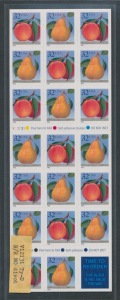One of the more ironic things about specialized philately is that collectors are far more likely to collect older issues in a highly specialized degree than they are to collect more modern stamps in the same degree of detail. Penny Blacks are specialized by plate number. There were 12 plates- each of which can only be told by detailed examination against known plated stamps) and 240 positions on each sheet (one for each set of check letters) making 2880 collectible stamps of the first postage stamp alone. Of the Penny Red of 1841, the second GB stamp, there are tens of thousands of different collectible varieties. Collectors of modern stamps usually collect only one of each, but this is out of habit. Many collectible varieties of modern stamps exist, and collectors of United States should be aware of this. The decision of how specialized to make your collection is yours alone, but this decision is easier to make if you are informed about varieties that are available.
Modern US booklets are a specialist's dream. They have different configurations and formats and plate numbers. Scott is only an introduction to these stamps; the modern Die Cut stamps are another area with many varieties. Die Cutting is really just a modern form of rouletting, which was used on the Nineteenth Century stamps of Finland, among others. As of now, the full specialty potential of modern United States stamps is barely being tapped. Few specialty societies exist, and those few collectors that there are mostly concentrating on plate number coils.
Here is what I see happening: Down the road people will begin to specialize in plate studies of modern US stamps. They will want the booklet configurations, plate numbers on stamps and coils, luminescence varieties, Die Cut varieties, and Press Sheet crossed gutters (as is collected with the Farleys) and other esoterica. And they will find that many of the scarcer varieties were never identified by buyers and were used as postage and can't be found. And prices on some of the scarcer material will rise rapidly. And more collectors will flood into the field, attracted by the publicity of rising prices, looking for this material and causing prices to grow even faster. And collectors will look back and see that they could have collected these stamps at fractions of the currently asked prices if only they knew. Modern US is still an inexpensive and fascinating specialty that has great growth potential.

